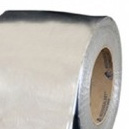What Are The Basic Characteristics Of Good Adhesive Tapes?
- 7 August 2015
- Posted by: Madhuraka
- Category: Article
 Manufactured products are fastened or glued together by marvelous engineering processes. Screws retain walls and welded joints secure metal components, bonding one metal part to another. Adhesive tape represents another innovative means of accomplishing this fastening chore. At a rudimentary level, we see tape as plastic strips of film. Non-stick on the outer facing side, the working side is laced with a tacky adhesive. On application, the pressure-sensitive adhesion (PSA) properties of the sticky stuff bond either to another piece of tape or to another surface. It’s an adhesive format that reinforces the fastening tasks mentioned above, but the method also positions adhesive tape as a third solution, that of a robust sealant. In short, tape can hold items together, stick to itself or another surface, and can easily function as a sealing agent.
Manufactured products are fastened or glued together by marvelous engineering processes. Screws retain walls and welded joints secure metal components, bonding one metal part to another. Adhesive tape represents another innovative means of accomplishing this fastening chore. At a rudimentary level, we see tape as plastic strips of film. Non-stick on the outer facing side, the working side is laced with a tacky adhesive. On application, the pressure-sensitive adhesion (PSA) properties of the sticky stuff bond either to another piece of tape or to another surface. It’s an adhesive format that reinforces the fastening tasks mentioned above, but the method also positions adhesive tape as a third solution, that of a robust sealant. In short, tape can hold items together, stick to itself or another surface, and can easily function as a sealing agent.
A Study of the Two Components of Adhesive Tape
On one side, the tape is composed of a non-stick base material, a thin plastic film that’s typically manufactured as a roll. The adhesive material is sandwiched between the coiling layers of tape and lightly bonded in place until needed. Here’s a brief list of the benefits that come with buying adhesive tape:
- No chemical bonding involved
- The tape possesses electrical insulating properties
- Conforms precisely to applied surface to create excellent seals
- Pressure sensitive application
The benefits implied by this mode of adhesive application are numerous. The tape can be wound many times around the surface, thus reinforcing the seal. Application is also mess-free and, unlike free-flowing adhesives, the application process can be reversed, thus removing the tape for a maintenance task or the application of a fresh layer. Additionally, adhesive tapes, by their very nature, eliminate lingering stickiness issues by providing that essential non-stick outer side. It should be noted at this point that both of these components are open to near unlimited customization. Obvious changes to this successful adhesion formula include a double-sided stickiness configuration or the substitution of the plastic film with a hardier material.
Dwelling on the Basics of Adhesive Tape
Film type adhesive tape is considered fragile when compared to fabric-reinforced adhesive tape, a product made popular by the packaging industry, but it survives by focusing on malleability. The plastic can conform to any shape, thus ensuring the tape fills every crack and crevice. Rubberised adhesive tapes also assume this responsibility, but added durability identifies this form of tape as more suitable for plumbing or construction work.
Single-sided, double-coated, or reinforced, adhesive tapes offer temporary and permanent sealing configurations. There’s no chemical bonding to worry about, meaning cohesive forces can be negated with minimal effort. Meanwhile, tough industrial-class adhesive tapes reduce elongation characteristics while increasing tensile strength and surface adhesion integrity. This class of tape is commonly found in the construction industry and as a reinforcing seal on air conditioning ducts.

